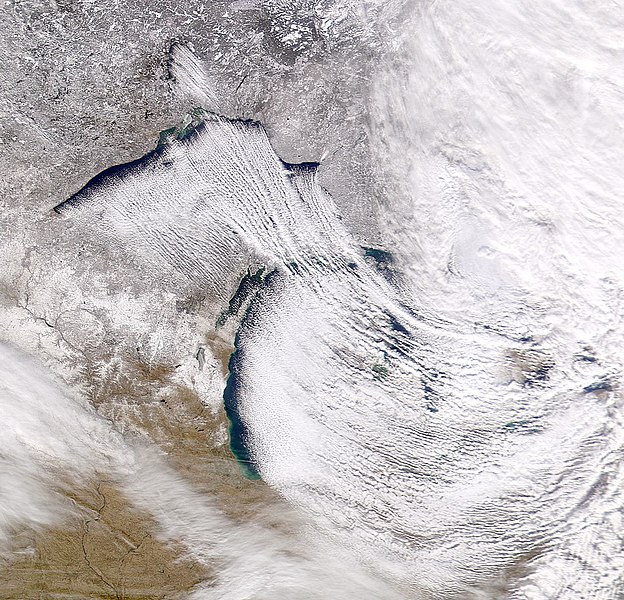We live in the land of lake-effect snow - between two lakes - Georgian Bay (Lake Huron) and Lake Simcoe. This means that when you look at the radar, everywhere else is clear and there's a big green line connecting those two lakes and we are underneath it.
 |
| Looking for us? Try the big green blob. |
Lake-effect snow: streamers, snow squalls, snow bands, whatever the name - it results in a fair bit of the white stuff. We hear these terms on the radio a lot so it's not surprising that Beans wanted to know what it was and how is it different than regular snow? And why doesn't her uncle have any snow?
 |
| Sometimes it's hard to find your toys. |
The answer is that it's not different than regular snow. Snow is snow - it's precipitation that falls in a frozen state. Clouds form when water vapour condenses (goes from gas to liquid) and hang out in the atmosphere, then when they get too heavy they fall - and because it's cold it's not as water, it's as tiny ice crystals. It is actually usually so cold in the clouds that most rain actually starts out as snow, even in summer, but melts on its way down! As Bunny learned the other day from her favourite show
Wild Kratts, snow isn't just water - there is dirt, bacteria and other random things in there from the atmosphere that help the snow freeze faster and form the crystalline structure, so she's not so sure about catching it on her tongue anymore. A bunch of those ice crystals fuse together and form a snowflake. Sometimes they melt and refreeze and then you get the harder ice balls and not so much the nice fluffy stuff. And sometimes those go sideways in the wind and hit you in the face while you dig out the car.
 |
| Pretty little crystalline structures (this one is not my pic) |
But overall snow is snow - what is different in lake-effect snow is not the what but the HOW.
Whenever you have a large body of water it has an effect on the local weather. When the atmosphere is cool and the cold winds blow across the lake water, which is significantly warmer, it picks up the water vapour, freezes it and because so much has accumulated it dumps it right there on the shore. So whoever is on the prevailing leeward side of a lake get the snow jackpot. Because of where we are situated - surrounded by water, we get most of our snow from the lake when the wind is from the west, and then some from your regular winter storms too. There is snow in the forecast every day this week. Uncle Chris doesn't live on the leeward side of a lake, even though he does live near a large lake (Ontario), so most of the snow picked up by his lake gets dumped on the fine people of upstate New York. (NOTE: as I finished putting this together, southern Ontario got dumped on by a winter storm, so Uncle Chris has snow now).
 |
| Lake-effect snow in the Great Lakes (also not my pic!) |
Luckily both girls seem to have a love of snow. Bunny a little more than Beans, who still seems to manage to get snow inside her snowsuit, no matter how much I attempt to get her all tucked in. Bunny will spend hours flinging herself down a hill, which is good because snow here starts in November and lasts until April (Started in October this year... and the odd early May snow flurry is not unheard of) and our yard happens to be a hill.
 |
| A young Bunny one November... |
 |
| ...and this was taken at Easter |
I've been told people like pictures, so to end, a wintry collection of pictures of snow and snow related fun. Mostly because I had fun looking for old snow pictures!
 |
| This year. But we have more now. |
 |
| If you have a lot of snow, you might as well celebrate it! |
 |
| A walk in the snowy woods. |
 |
| A lovely snow seat in the snowy woods. |
 |
| WALKING IN THE SNOWY WOODS IS HARD! |
 |
Bunny. Toboggan. Snow Squall.
This is standard practice for her. |
 |
| No post on snow is complete without a snowman! There. Done. |
http://www.weatherwizkids.com/weather-winter-storms.htm
http://adventure.howstuffworks.com/outdoor-activities/snow-sports/snow-maker1.htm
http://en.wikipedia.org/wiki/Snow
http://en.wikipedia.org/wiki/Lake-effect_snow












